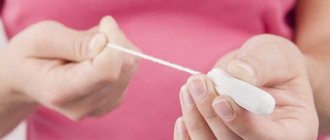Lasers, originally created for industrial purposes, have long been used to treat many serious diseases. This technology is used in almost all branches of medicine, and gynecology is no exception. After all, laser therapy is one of the safest and most effective treatment methods, which is especially important when it comes to preserving a woman’s reproductive capabilities.
What is laser therapy: description of the technology, its advantages
Laser therapy is a type of therapeutic effect on body tissues, implemented using directed rays of light corresponding to a certain spectrum. Its use allows you to achieve the following results:
- strengthening the body's defenses;
- activation of internal regulation processes;
- improvement of blood circulation in the area of influence;
- elimination of foci of inflammation;
- pain relief;
- mobilization of the body's bioresources;
- increasing the speed of recovery processes.
If you compare laser therapy with other treatment methods, you will notice that it has several significant advantages, including:
- Painless.
- The presence of a noticeable positive result after the first session of therapy.
- Increasing the effectiveness of the medications used (this allows you to reduce their dosage).
- Low level of blood loss (the laser instantly cauterizes all vessels injured during treatment).
- High accuracy of impact.
- Short duration of the procedure.
- Absence:
- addiction;
- allergies;
- other side effects.
- Acceleration of the healing process by 2-3 times.
- Low likelihood of complications.
- Increasing time gaps between relapses of the disease (in the chronic form of the pathology).
- Maintaining the achieved result for a long time.
Using the laser is very simple, so if necessary, treatment can be carried out on an outpatient basis.
Properties
Treatment of gynecological pathologies with a laser is based on the action of a directed light flux on the affected tissue. This method of physiotherapy is safe for patients and allows you to achieve positive dynamics in a short time.
Therapeutic laser in gynecology can have the following effects:
- improvement of local blood circulation;
- stimulation of the immune system;
- relief of symptoms of inflammatory pathologies;
- elimination of pain syndrome;
- acceleration of recovery processes.
Laser treatment in gynecology has a number of advantages over other methods, namely:
- Painless and well tolerated.
- Noticeable effect after the first session.
- Potentiates (strengthens) the effect of medications, making it possible to reduce the dose of medications.
- Does not provoke addiction.
- Does not give adverse reactions, either allergic or any other.
- Speeds up recovery several times.
- Extends the period of remission of chronic pathologies.
- In addition, the ease of implementation of this physiotherapeutic technique allows you to undergo treatment courses on an outpatient basis, and not just in a hospital.
Features of the species
Therapeutic methods associated with the use of lasers are highly diverse. But only four of them are used to combat diseases of the female reproductive system.
Photon Laser
The technology implemented through the Fotona device bears the same name. It is used for various operations (including plastic surgery).
The Photon laser, in the process of influencing a woman’s reproductive organs, stimulates the intensive production of collagen fibers. This helps to increase the elasticity of tissues , their structure is renewed. The vagina becomes narrower in shape. The tone of the pelvic floor muscles also .
Therapeutic
This technique allows the specialist to directly influence the patient’s blood flow. For these purposes, a special conductor device is used, which is placed in a venous vessel.
The procedure allows you to:
- have a stimulating effect on metabolic processes ;
- activate the body's defenses ;
- relieve pain;
- relieve inflammation;
- increase the ability for self-regulation .
In accordance with the type of effect provided, the method can be classified as physiotherapeutic.
Carbon dioxide (CO2)
CO2 lasers were among the first to be introduced into medicine, and therefore they have a serious drawback : the ability to significantly damage healthy tissue adjacent to the area of influence.
For what diseases is it used in gynecology?
Treatment using laser radiation may be recommended if the patient has the following pathologies:
- Chronic and subacute inflammation affecting the reproductive organs.
- Dysfunctions:
- ovaries;
- hypothalamus;
- pituitary gland
- Scars, adhesions and benign neoplasms in the pelvic area.
- Presence in obstetric history of complications in the form of:
- miscarriages;
- stillborn children;
- fetuses that died during intrauterine development.
- Pathologies of the cervix (including its erosion).
- Painful, heavy or scanty periods.
- Endometriosis.
- Infertility.
During pregnancy, laser therapy is used to get rid of toxicosis of the last trimester . This technology also helps to overcome fetoplacental insufficiency . After childbirth, a laser may be useful if you need:
- Accelerate the restoration of uterine tissue and healing of sutures located in the perineal area.
- Increase the volume of milk produced by the glands.
- Minimize the likelihood of complications during the postpartum period.
- Cure:
- cracks in the skin in the nipple area;
- lactation mastitis;
- lactostasis.
In addition, the laser will be useful for women who are recovering from diagnostic curettage, surgery on the reproductive organs or abortion.
obstetrics and gynecology
You can learn more about the methods of laser therapy in the books of the series “Fundamentals of Laser Therapy” and “Effectiveness of Laser Therapy”: Moskvin S.V., Achilov A.A. Basics of laser therapy. – M.–Tver, Triada Publishing House LLC, 2008. – 256 p. Moskvin S.V., Geinits A.V. Intravenous laser blood illumination. – M.–Tver, Triada Publishing House LLC, 2015. – 450 p. (NEW!!!) Fedorova T.A., Moskvin S.V., Apolikhina I.A. Laser therapy in obstetrics and gynecology. – M.-Tver: Triada Publishing House LLC, 2009. – 350 p. Attention! Links to pictures taken from the book: Moskvin S.V., Achilov A.A. Basics of laser therapy. – M.–Tver, LLC Publishing House “Triada”, 2008. – 256 pp., which can be purchased in stores or at the Scientific Research
Laser therapy can be performed in both inpatient and outpatient settings. The procedures are performed with the patient in the gynecological chair or couch. Today, the following approaches are most often used to apply laser radiation to the uterine appendages.
The first , the most common, is through the anterior abdominal wall. The emitting head of the infrared laser (best of all is a matrix emitter type ML01K for ALT “Matrix”) is located on the anterior abdominal wall in the area of the projection of the illuminated appendages. The area of projection of the appendages is clarified during a bimanual gynecological examination before laser therapy. When using the contact technique, i.e. when the laser emitter or the distal end of the light guide is in close contact with the skin, the penetration depth of laser radiation increases slightly due to the fact that blood is squeezed out of the vessels located in the skin and subcutaneous tissue, which reduces the absorption of laser radiation by surface layers of the anterior abdominal wall.
The second way is to deliver radiation through the vaginal vault using special light-guide instruments. Gynecological attachments are made of material with a high transmittance, which allows laser radiation to be delivered directly to the appendage area with minimal losses. For ease of use, it is better to have several sets of nozzles of different shapes and different sizes. To prevent infection of the light-guide instrument, it is convenient to use a condom, which is placed on the vaginal attachment before each procedure.
And finally, there is a third method - combined illumination using two or more laser emitting heads, one of which illuminates the uterine appendages through the vaginal vaults, and the other through the anterior abdominal wall. If there is a two- or multi-channel laser device, then illumination through the anterior abdominal wall and through the vaginal fornix can be carried out simultaneously. Apparently, the combined method of exposure is the most optimal, since it is the most effective and significantly reduces the time of the procedure.
All three methods of delivering laser radiation to the uterine appendages can be successfully used in most women. However, to achieve maximum effect, you should pay attention to the individual characteristics of the body. In obese women with a large thickness of the anterior abdominal wall, preference should be given to the transvaginal route of laser light, while in patients with a weak subcutaneous fat layer, it is possible to illuminate the appendages through the anterior abdominal wall. In some cases (patient reluctance, vaginismus, virgo, etc.), the vaginal route of radiation delivery should undoubtedly be excluded.
Laser therapy sessions are carried out daily, preferably at the same time. The course of treatment consists of 7–15 sessions, depending on the individual characteristics of the disease. Quite often, after 3–6 procedures, women with chronic inflammatory diseases experience an exacerbation of the process.
Laser therapy is carried out both as an independent method and as part of a treatment complex for subacute and chronic inflammatory diseases of the female genital area.
The traditional list of means for the complex treatment of inflammatory diseases of the genital area includes antibacterial therapy, physiotherapy (ultrasound, electrophoresis), restorative and immunostimulating therapy. The integrated use of laser, physiotherapy and antibacterial therapy makes it possible to obtain a pronounced clinical effect that is superior to the effect of each of the component treatment methods separately.
Laser therapy is prescribed from 5–7 days after the start of menstruation.
In addition to general contraindications for laser therapy in gynecology, there are the following:
- Fibrocystic mastopathy.
- Uterine fibroids.
- Itching of the vulva due to diabetes mellitus, helminthic infestation.
- Acute bartholinitis in the abscess stage.
- A suppurating Bartholin gland cyst.
- Ovarian tumors and cysts.
Normalization of the menstrual cycle, treatment of ovarian dysfunction and algodismenorrhea
After receiving confirmation in the experiment of the possibility of influencing the activity of the cortex, a number of subcortical nuclei (supraoptic, paraventricular, etc.), with the help of LILI, on the activity of the pituitary gland, adrenal glands and ovaries, i.e., on the endocrine system as a whole, laser therapy began to find everything wider use in gynecological practice for the regulation of menstrual function, treatment of ovarian dysfunction, algodismenorrhea, stimulation of ovulation in the treatment of infertility, for the treatment of certain neuroendocrine syndromes.
As with traditional methods of treating dysfunctional uterine bleeding (DUB), treatment with laser therapy involves two stages. At the first stage, bleeding is stopped, and at the second stage, menstrual function is normalized.
Laser therapy is carried out as follows. The cervix is exposed in the speculum and dried with a sterile swab; the area of the external os of the cervical canal is illuminated. During the procedure, it is necessary to ensure the alignment of the laser beam and the cervical canal.
LT technique. When using a emitting head type KLO3 to the ALT “Matrix”, the effect can be carried out either directly from the emitter or through a light guide instrument with a special attachment (G-1 or G-2). Recommended parameters: wavelength 635 nm, power 10 mW, for 4–5 minutes. When using IR pulsed lasers, radiation is carried out using a straight end or special neck attachment (G-1 or G-2). Power 15–20 W, pulse repetition rate 1500–3000 Hz, for 4–5 minutes. It should be noted that the area of the external pharynx in almost all cases does not exceed 1 cm2.
If it was possible to stop the bleeding using laser radiation (which takes from 3 to 10 sessions), then the hemostatic effect remains in approximately 2/3 of patients during the first year. However, to obtain a stable long-term effect, it is advisable to conduct rehabilitation courses of laser therapy after 3–6 menstrual cycles. The purpose of rehabilitation courses is to gently stimulate the central and peripheral parts of the reproductive system, to normalize the cyclic secretion of gonadotropins and, accordingly, to normalize the ovarian and uterine cycles.
RT technique (at the second stage). A course of laser therapy is prescribed in the first phase of the cycle, immediately after the end of the next menstruation. The procedures are carried out daily, once a day is better at the same time, the duration of the course is 7–12 days, depending on the length of the menstrual cycle in a given patient.
The ovaries and the area of the external os of the cervical canal are illuminated. The radiation is applied using a vaginal attachment (G-2) to the right and left appendages of the uterus, as well as to the area of the external os of the cervical canal for 1.5–2 minutes. Power (IR pulse laser, LO2 or LO3 head with a mirror attachment for the Matrix ALT) 5–7 W, frequency 80 Hz.
If the patient is virgo, illumination of the appendages is carried out through the anterior abdominal wall for 1.5–2 minutes on each side, emitting head ML01K, power 40–50 W, frequency 1500 Hz. It is better to use the contact technique, exerting moderate pressure on the anterior ruchal wall for deeper penetration of radiation.
A relative contraindication for irradiation through the anterior abdominal wall is severe obesity.
Treatment of certain types of infertility, ovarian hypofunction, some forms of diencephalic pathology and hypothalamic-pituitary disorders
Laser therapy can be successfully used not only to treat DUB, but also to correct a fairly large number of pathological conditions of the reproductive system. Encouraging results have been obtained using laser therapy to treat some forms of infertility, ovarian hypofunction with inferiority of the first and second phases of the menstrual cycle, some forms of diencephalic pathology and hypothalamic-pituitary disorders.
The problem of treating pathology of the reproductive system is relevant for a number of reasons. Firstly, a high frequency of infertile marriages is observed everywhere (up to 14–19% in the population). Secondly, the treatment methods available today are not highly effective.
LT technique. The course consists of 5–8 sessions. The first session is carried out 1–2 days after the end of the next menstruation. Then sessions are carried out daily once a day, preferably at the same time. The effect is carried out intranasally using a nozzle L-1–2 (from the ENT set of nozzles for the ALT “Matrix”), which is inserted to a depth of 2–5 cm into each nasal passage.
Procedure parameters for continuous laser radiation with a wavelength of 635 nm (KLO3 head for ALT “Matrix”): power 8–10 mW (at the output of the emitting head without a nozzle), exposure time 1.5–2 min for each area.
Procedure parameters for pulsed IR laser radiation with a wavelength of 904 nm (LO3 head for ALT “Matrix”): power 10–15 W (at the output of the emitting head without an attachment), frequency 1500 Hz, exposure time also 1.5–2 min per every area.
With the help of intranasal irradiation, the diencephalic, hypothalamic and pituitary structures responsible for the regulation of the central parts of the reproductive system are activated.
In parallel with intranasal exposure, the ovaries are illuminated, as during the rehabilitation course in patients with DUB (see above). The impact is carried out through the vaginal vaults or through the anterior abdominal wall.
Intravenous laser blood illumination (ILBI) has an immunomodulatory and anti-inflammatory effect. Under the influence of ILBI, the rheological properties of blood improve, metabolic processes and the body’s defenses are normalized. As a result, after 2–3 months, women’s menstrual cycle and hormonal disorders normalize, in half of the cases degenerative changes in the nuclear material disappear, and the number of oocytes that have a normal structure increases [Ivanyuta L.I. et al., 2001].
ILBI technique. ALT “Matrix-ILBI”, emitting head CL-ILBI, wavelength 0.63 µm, power at the end of the light guide 1.5–2.0 mW, procedure duration 15-20 minutes. A total of 5-6 daily sessions per course from the 7th day of the cycle.
Low-intensity laser radiation can also be used to treat algodismenorrhea. Laser therapy is indicated for primary algodismenorrhea. For secondary algodysmenorrhea, especially associated with endometriosis, the effectiveness of RT is not very high. The effect of LT for algodismenorrhea is apparently associated with the primary analgesic effect of laser radiation, with an antispasmodic effect, and with improved microcirculation. In addition, activation of steroidogenesis and, probably, a certain indirect effect of laser radiation on prostaglandin metabolism also have a positive effect in primary algodismenorrhea. LT technique. The ovaries on both sides, the body of the uterus and the area of the external os of the cervical canal are exposed to irradiation. When irradiating through the anterior abdominal wall, 3 irradiation fields are used: at the points of projection of the ovaries and above the womb along the midline towards the body of the uterus. When using vaginal attachments, the uterine body is illuminated through the anterior or posterior vaginal fornix, depending on the position of the uterus. Illumination of the appendages and external os of the cervical canal is carried out as in the treatment of DUB. The course of treatment includes 6–9 sessions of laser therapy. Of these, 3–4 sessions are carried out in the first phase of the cycle after the end of the next menstruation. The remaining 3–5 sessions are performed in the second phase of the menstrual cycle, immediately before the start of the next menstruation.
Laser therapy of true erosions and pseudo-erosions of the cervix
Considering the beneficial effect of LILI on reparative tissue regeneration, epithelization, reduction of the exudative phase of the inflammatory process, acceleration of collagen maturation, and stimulation of microcirculation, laser therapy has proven to be an effective method for treating diseases of the cervix, vagina and vulva. The list of diseases for which the use of low-intensity laser radiation in the visible (wavelength 635 nm) and infrared (wavelength 904 nm) regions of the spectrum can be very effective is quite wide: pseudo-erosion of the cervix, true erosion of the cervix, endocervicitis, colpitis, some viral lesions of the lower department of the female reproductive tract and a number of diseases of the genital area, which are discussed in other sections of this work.
One of the most common diseases is cervical pseudo-erosion, the proportion of which among cervical diseases, according to our data, is up to 60–70%. In some cases, laser therapy using LILI is indicated, and in some cases, with a high-energy CO2 laser.
To obtain a good therapeutic effect, careful selection of patients who are indicated for LILI laser therapy is necessary. The use of laser therapy without taking into account objective criteria, indications and contraindications for the choice of treatment leads to a decrease in the effectiveness and discredit of the method.
Before prescribing low-energy laser therapy, the patient should be thoroughly examined to the same extent as when prescribing high-energy laser therapy (CO2 laser). When deciding what type of laser radiation is optimal for a given woman, we suggest using a number of objective criteria:
- Assessment of parity, i.e. reproductive function. In the absence of a history of pregnancy or childbirth and if the other conditions listed below are met, you should first think about laser LILI therapy. If there is a history of pregnancy and childbirth (especially multiparous and multiparous women), then, as experience shows, LILI laser therapy is not always effective. Often, for such women, high-energy laser therapy using a CO2 laser (Lancet laser therapy) is much more effective.
- The area of pathologically altered tissue on the cervix. Laser therapy LILI is effective for small erosions (no more than 1–2 cm2). If the area of erosion is large or covers the entire surface of the ectocervix, then the effectiveness of low-intensity laser radiation therapy in most cases is low and such women should be treated with a CO2 laser.
- Duration of existence of erosion and previous treatment methods. Good results when using low-intensity laser radiation are achieved in women with erosion lasting no more than 1–2 years, who used only conservative methods of therapy or were not treated at all. In the presence of long-term, long-term erosions, especially in the presence of a history of surgical treatment methods (diathermocoagulation, cryodestruction, electroconization and other surgical interventions on the cervix), in the detection of pronounced organic changes (ruptures after previous abortions and childbirth, cicatricial deformities after gynecological and plastic surgeries , after surgical treatment of cervical diseases), the method of choice is high-energy laser therapy with a CO2 laser, and LILI turns out to be less effective.
- Complicated obstetric and gynecological history. If a woman has severe neuroendocrine disorders (amenorrhea, ovarian dysfunction, delayed puberty, etc.), the prognosis for treating erosion with LILI is unfavorable, and such women should be treated with a CO2 laser.
Detection of erosion against the background of pronounced organic changes (consequences of cervical ruptures after induced abortions, spontaneous miscarriages, childbirth, plastic surgery on the cervix) also casts doubt on the effectiveness of treatment of erosion with LILI, and such women need treatment with a CO2 laser, radiation of which in most cases allows to eliminate gross scar changes and restore correct anatomical relationships.
The above criteria allow us to determine with a high degree of certainty which method of treatment will be the most acceptable and most effective. With careful assessment of indications (using objective criteria) and correct selection of patients, the effectiveness of monotherapy using low-intensity laser radiation for the treatment of cervical diseases is 60–70%, depending on the nosology and treatment method. When laser therapy is carried out without taking into account the objective criteria discussed above, the effectiveness of treatment is significantly reduced, which can lead to discrediting the method.
LT (LLLT) technique. It is better to start treatment after the end of the next menstruation in the first phase of the menstrual cycle. Procedures are carried out daily, preferably at the same time. The total number per course is on average 15–20 procedures. If the dynamics are positive, the duration of treatment can be increased.
The procedure is performed on a gynecological chair or couch. The cervix is exposed in the speculum, mucus and discharge are carefully removed with a tupper. The entire erosion area is exposed to irradiation. Radiation can be supplied:
- directly from the emitter;
- through a system of mirrors;
- through special gynecological attachments adapted to deliver radiation to the cervix (G-1 or G-2).
Procedure parameters for continuous laser radiation with a wavelength of 635 nm (KLO3 head for ALT “Matrix”): power 8–10 mW (at the output of the emitting head without a nozzle), exposure time 1.5–2 min. Procedure parameters for pulsed IR laser radiation with a wavelength of 890 nm (LO3 head for ALT “Matrix”): power 10–15 W (at the output of the emitting head without an attachment), frequency 80 Hz, exposure time also 1.5–2 min.
Postpartum endometritis
One of the most important tasks in the postpartum and postoperative periods is to optimize the course of all components of inflammation and remove the postpartum mother’s body from the state of transient immunodeficiency associated with pregnancy and surgery. Recently, fundamentally new technologies have emerged that are used in molecular biology and medicine, which have a systemic effect on the human body and create the prerequisites for the development of new methods for combating infection.
Magnetic laser therapy is carried out to obtain anti-inflammatory, analgesic, immunomodulatory and antispasmodic effects (against the background of adequate antibacterial treatment). LT technique. The procedures are carried out daily 2–3 times a day with breaks of 3–4 hours for 2–3 days (emitting head LO2 (LO3), frequency 80 Hz, pulse power 5–7 W or matrix emitting head ML01K, pulse radiation power 50 W, frequency 80 Hz). Effect for 1.5–2 minutes sequentially on zones 3, 4, 5, 6, 7 (Fig. 140, p. 222 from the book: Moskvin S.V., Achilov A.A. Fundamentals of laser therapy. - M. – Tver, LLC Publishing House “Triada”, 2008. – 256 p.).
Nonspecific salpingitis and salpingoophoritis (subacute and chronic)
It is legal to carry out laser therapy in an acute process only at the end of the exudative phase of inflammation. Treatment should begin at the end of the acute stage of inflammation, during the transition of the acute process to the subacute, the exudative phase to the proliferative one. Before the procedure, you should empty your bladder. The patient should be on the couch in a supine position with her knees bent and her pelvis raised for better removal of the appendages.
In the treatment of adnexitis, LILI can be used in conjunction with prodegiosan. A course of laser therapy begins after 2-3 injections of prodegiosan. LT technique. Contact, stable, percutaneous in the areas of projection of the uterine appendages sequentially for 1.5–2 minutes on areas 1, 2, 3, 4, 6 (with moderate compression of soft tissues) (Fig. 140). ALT "Matrix", emitting head LO2 (LO3) with a mirror attachment ZN-50, wavelength 904 nm, pulse power 5–7 W, frequency 80–150 Hz or pulse emitting head LOK2, wavelength 635 nm, pulse power maximum – 3–5 W, frequency 80–150 Hz.
It is possible to carry out an intracavitary technique along the arches (Fig. 140, p. 222, zone 8 from the book: Moskvin S.V., Achilov A.A. Fundamentals of laser therapy. - M.-Tver, LLC Publishing House "Triada", 2008. – 256 pp.). For transvaginal irradiation (area), special gynecological nozzles with a pre-installed condom are used (the type of nozzle is selected by the gynecologist depending on the specific task). The posterior and lateral vaults of the vagina are exposed for 2 minutes per field every other day or daily. Most often, the emitting head KLO3 is used, wavelength 635 nm, maximum power.On this day, transdermal exposure is not carried out.
For transvaginal irradiation (area), special gynecological nozzles with a pre-installed condom are used (the type of nozzle is selected by the gynecologist depending on the specific task). The posterior and lateral vaults of the vagina are exposed for 2 minutes per field every other day or daily. Most often, the emitting head KLO3 is used, wavelength 635 nm, maximum power.On this day, transdermal exposure is not carried out.
Carrying out complex therapy of patients with acute salpingo-oophoritis using ILBI leads to a reduction in treatment time, normalization of hemoglobin levels, the value of the dry mass of erythrocytes and indicators of their osmotic resistance, the number of normal discocytes and the size of the central cavity of erythrocytes. With the help of these mechanisms, local physiological processes are realized, in particular, activation of microcirculation and improvement of tissue oxygenation, which in turn leads to an increase in the intensity of energy, synthetic and proliferative processes in blood cells and tissues [Davydova Yu.G., 1996]. ILBI technique. ALT “Matrix-ILBI”, emitting head CL-ILBI, wavelength 635 nm, power at the end of the light guide 1.5–2.0 mW, procedure duration 15-20 minutes. There are 5-7 daily sessions per course.
Bartholinitis acute (in the infiltration stage), subacute and chronic
Contraindications: acute bartholinitis in the abscess stage, festering cyst of the Bartholin gland (for cysts and recurrent pseudo-abscesses of the large gland of the vestibule, laser therapy is indicated in terms of preoperative preparation (3-5 procedures), which accelerates the healing time of the postoperative suture and reduces the percentage of postoperative suppuration). LT technique. Contact, stable on the area of the affected gland through 2-3 layers of gauze. ALT “Matrix”, pulse matrix emitting head ML01K with magnetic attachment MM-50, wavelength 904 nm, pulse power 50–70 W, frequency 80 Hz.
Colpitis, cervicitis (endocervicitis)
Thanks to the multifaceted effects of low-intensity laser radiation on microcirculation, epithelization, local and general immunity, laser therapy expands the capabilities of gynecologists in the treatment of colpitis and cervicitis.
Indications: subacute and chronic serous-purulent, fungal, senile colpitis, herpetic colpitis. Laser therapy for senile colpitis is most effective. For all types of colpitis, RT is carried out against the background of standard drug treatment with daily sanitation of the vagina before the procedure.
Method 1. Combined. Intravaginal irradiation is carried out (Fig. 140, zone 8 from the book: Moskvin S.V., Achilov A.A. Fundamentals of laser therapy. - M.-Tver, LLC "Publishing House "Triada", 2008. - 256 p.), emitting KLO3 head with gynecological attachment, wavelength 0.63 µm, maximum power. A condom is put on the nozzle, which is lubricated with an appropriate (according to the disease profile) drug. Then, a magnetic laser effect is performed using a matrix emitting head ML01K with a magnetic attachment MM-50, wavelength 904 nm, pulse power 50–70 W, frequency 80 Hz on the area of the vaginal entrance (Fig. 140, zone 7 from the book: Moskvin S.V. , Achilov A.A. Basics of laser therapy. - M.-Tver, Triada Publishing House LLC, 2008. - 256 pp.) from a distance of 1 cm using the scanning method for 2-3 minutes and to pain areas (Fig. 140 , zone 6) in the sacrolumbar region (identified by palpation). Method 2. Approximate diagram (acupuncture points are indicated, additional to the basic recipe - see Fig. 141, p. 223 from the book: Moskvin S.V., Achilov A.A. Basics of laser therapy. - M.-Tver, LLC " Publishing house "Triad", 2008. – 256 pp.):
1st procedure: pulse repetition rate 80 Hz, exposure 2 minutes, intravaginal. Basic recipe. 2nd procedure: pulse repetition rate 80 Hz, exposure 2 minutes, intravaginal; external illumination of the introitus using a magnetic laser attachment (induction 35–50 mT) from a distance of 1–2 cm using the scanning method for 2 minutes at a pulse repetition rate of 80 Hz. To acupuncture points: V 53, V 58 (wavelength of continuous radiation 0.63 µm, 1.5–2 mW at the output of the acupuncture nozzle A-3). 3rd procedure: parameters and method of exposure, as in the 2nd procedure: R 4, R 10, V 55. 4th procedure: pulse repetition rate 80 Hz, exposure 2 minutes, intravaginal; external illumination for 1 min at a pulse repetition rate of 1500 Hz. To acupuncture points: VB 28, VB 29, F 2. 5th procedure: parameters of the 4th procedure: F 10, F 11, VC 1. 6th procedure: pulse repetition frequency 80 Hz, exposure 4 minutes, intravaginally; external illumination for 1 min at a pulse repetition rate of 1500 Hz. Zones of the lumbosacral region (2–3) for 1 min, contact-mirror method, pulse repetition rate 150 Hz. For acupuncture points: VC 2, F 12, VB 27. 7th procedure: parameters of the 6th procedure. At acupuncture point G 110. 8th procedure: intravaginal scanning, circular movements along the vaults and walls of the vagina from the cervix to the entrance to the vagina for 4 minutes at a pulse repetition rate of 1500 Hz, external illumination of the introitus for 1 minute at a frequency of 80 Hz and the center of the Michaelis rhombus region for 1 min using the mirror contact method. To acupuncture points: P 7, R 6. 9th procedure: the parameters of the 8th procedure are repeated. To acupuncture points: R 3, R 12. 10th and 11th procedures: intravaginally at a pulse repetition rate of 80 Hz for 4 minutes; external illumination of the introitus at 80 Hz for 1 min, the center of the Michaelis rhombus and the center of the suprapubic region at a frequency of 80 Hz for 0.5 min each. To acupuncture points: TR 5, VB 39, VB 41. 12th and 13th procedures: intravaginal scanning throughout the entire vaginal volume at a pulse repetition rate of 80 Hz for 2 minutes. No laser reflexology.
The course can be repeated in a month. Before laser and magnetic laser therapy, oncocytological examination of smears from the vaginal part of the cervix and aspirate from the cervical canal is necessary. ILBI has an immunomodulatory and anti-inflammatory effect, stimulates microcirculation and regeneration processes. The duration of treatment for patients with endocervicitis is reduced by 5–7 days, healing occurs 2 times faster, there are no relapses, the number of purulent-inflammatory diseases in postpartum women decreases 2–2.5 times [Ivanyuta L.I. et al., 1993]. ILBI technique. ALT "Matrix-ILBI", emitting head CL-ILBI, wavelength 635 nm, power at the end of the light guide 1.5–2.0 mW, procedure duration 20-30 minutes. Additionally, daily exposure is carried out directly on the eroded surface of the cervix with a power density of 5–10 mW/cm2 (ALT “Matrix”, emitting head KLO3, wavelength 635 nm). The first session is 3 minutes, then increases by 1 minute, maximum 15 minutes.
Kraurosis of the vulva, idiopathic neurogenic pruritus of the vulva
Laser therapy has a pronounced effect due to the normalization of microcirculation, improvement of tissue trophism, including nerve endings, analgesic effect, stimulating effect on local and humoral components of the immune system. Treatment is carried out in combination with drug therapy. Before the procedure, a targeted biopsy from areas suspected of malignant degeneration, oncocytological examination of smears of the vaginal portion of the cervix, and cervical aspirate are indicated. Contraindications: vulvar cancer, vulvar itching due to diabetes mellitus, helminthic infestation. LT technique. Distant, labile (distance from the emitter 1 cm). ALT "Matrix". Magnetic laser exposure (scanning) of the focus of kraurosis (labia majora, labia minora, pubis, perineum) is carried out (Fig. 140, p. 222, zone 7 from the book: Moskvin S.V., Achilov A.A. Fundamentals of laser therapy. - M .–Tver, LLC Publishing House “Triada”, 2008. – 256 p.). Then zones 4 and 6 (Fig. 140) are stably contacted with a emitting head LO2 (LO3) with a magnetic attachment ZM-50, pulse power 7–10 W, frequency 80–150 Hz. If necessary, a second course of treatment is carried out after 3–4 weeks.
Cracked nipples, lactostasis, hypogalactia in postpartum women
In the treatment of cracked nipples and the prevention of lactation mastitis, the reflexogenic zones of the mammary glands, rich in nerve endings, are exposed to LILI. LILI, used in the prevention of mastitis, does not have a significant effect on the level of prolactin in postpartum women with a normal level of lactation and has a stimulating effect on the level of prolactin and lactation in postpartum women who, along with cracked nipples, have hypogalactia. LILI helps reduce the level of follicle-stimulating hormone in postpartum women, but does not have a significant effect on the level of luteinizing hormone, estradiol and progesterone. LILI has an effect on the immune system of the postpartum mother, activates the humoral component, and helps to increase the levels of immunoglobulins (Ig) A, M, G and lactoferin. in blood serum, has a stabilizing effect on the level of trophoblastic beta1-glycoprotein in blood serum.
Contraindications: fibrocystic nodular mastopathy, mixed with a predominance of the cystic component. LT technique. ALT "Matrix". Treatment of lactostasis is carried out in two stages: first, exposure to the area of the nipple and areola (Fig. 142, p. 225, zone 1 from the book: Moskvin S.V., Achilov A.A. Basics of laser therapy. - M.-Tver, LLC “Publishing house “Triada”, 2008. – 256 pp.) remotely (distance 1 cm) with the emitting head ML01K (frequency 80 Hz, maximum power), or contact (through 2-3 layers of gauze) with the emitting head LO2 with a mirror magnetic attachment ZM- 50 (frequency 80 Hz, power 5–7 W) – slow movement in a circle. Then the upper-outer, upper-inner, lower-inner and lower-outer quadrants of the mammary gland are sequentially exposed to the LO2 emitting head with a magnetic attachment ZM-50 (frequency 80 Hz, pulse power 5-7 W) steadily for 1 minute per zone or with a slow movement in a circle for 2 minutes (zone 2). Expressing is recommended to be done within an hour after magnetic laser exposure.
To treat cracked nipples, magnetic laser exposure (Fig. 142) is applied to the nipple (zone 1) with slow circular movements after preliminary removal of milk residues and wound exudate.
Purulent-septic complications
Intravenous laser blood irradiation (ILBI) is indicated for women outside pregnancy and during pregnancy with a high risk of developing purulent-inflammatory complications [Non-drug method..., 2002]: patients with chronic salpingo-oophoritis, endometritis, colpitis; patients with a history of surgical interventions, childbirth complicated by purulent-inflammatory diseases; having a chronic viral infection (CMV, HSV), suffering from miscarriage, having a history of premature birth, intrauterine fetal death, the birth of children with intrauterine infection.
ILBI technique. ALT "Matrix-ILBI", emitting head CL-ILBI, wavelength 0.63 μm, power at the end of the light guide 1.5–2.0 mW. Exposure during the first five sessions is 15 minutes, during the next 2 sessions exposure is 30 minutes. A total of 7 daily procedures.
Indications for ILBI are [Non-drug method..., 2002]:
- Virus carriage (viruses of the herpetic group - H. simplex, H. genitalis, cytomegalovirus) - in preparation for pregnancy, in preparation for childbirth after 32 weeks of pregnancy.
- Typical and atypical form of genital herpes in preparation for pregnancy, in preparation for childbirth after 32 weeks of gestation.
- Chronic pyelonephritis in pregnant women after 32 weeks of gestation.
- Nonspecific salpingitis, salpingoophoritis.
- Chronic and subacute bartholinitis.
- Colpitis, endocervicitis.
- Endometriosis.
- Peritonitis (as a component in complex therapy).
- Sepsis (as a component in complex therapy).
- Intrauterine pneumonia of newborns.
Contraindications for ILBI [Non-drug method..., 2002]:
- Blood diseases.
- Hematological syndromes associated with blood hypocoagulation.
- Diseases of the cardiovascular system in the stage of decompensation.
- Diabetes mellitus in the stage of decompensation.
- Severe forms of thyrotoxicosis.
- Mental illnesses, psychasthenia.
- Acute febrile conditions of unknown etiology.
- Acute infectious diseases.
- Severe exhaustion, cachexia.
- Active forms of tuberculosis, actinomycosis, anthrax, syphilis.
- Neoplasms of malignant and benign nature of any location.
- Factor intolerance.
- Severe hypotension.
Possible complications [Non-drug method..., 2002]:
- Hypotension – the cause of this complication is initial hypotension, intolerance to the influencing factor. It is relieved by infusion therapy, the administration of antihistamines, and vasopressor drugs.
- Hypertension is considered as an individual response to an influencing factor. Treated with the administration of antihypertensive drugs.
Research conducted by the Scientific Center for Obstetrics, Gynecology and Perinatology of the Russian Academy of Medical Sciences to evaluate the effectiveness of using the ILBI method (1100 women, of which 300 were pregnant and 800 non-pregnant) before surgery or childbirth, in the postoperative or postpartum period in women with a high risk of developing purulent septicaemia
Help of this treatment method for infertility
The choice of a specific laser technology when dealing with the inability to have children will depend on the reason for which this problem arose.
- to remove tumors or unwanted areas of tissue (this type of therapy is supplemented by medication and endoscopic surgery).
- To get rid of a chronic infectious disease, a woman will need a course of several laser sessions.
- To improve the quality of male spermogram necessary:
- irradiation of the testicles, as well as the perineal and sacral areas (carried out through the skin or intravenously);
- prostate stimulation, which is performed rectally.
These procedures can significantly increase the likelihood of pregnancy.
Where to take the course
ON CLINIC has all the necessary equipment for conducting laser therapy procedures in gynecology. After consultation and examination, our doctors will select an individual course for you depending on the nature of the problem that is troubling you.
This is an ideal solution for combating not only female diseases, but also for increasing the tone of intimate muscles. The most popular service is vaginal plastic surgery or vaginoplasty. Efficacy and safety are confirmed by the results of clinical studies by Russian and foreign specialists.
Nasonova N.V. Gynecology services at ON CLINIC.
Make an appointment with our doctors right now and find out all the details you are interested in from the best professionals in Moscow.
Contraindications
The reasons for refusing to use laser therapy in the treatment of gynecological diseases may be:
- suppuration of a cyst located in the reproductive organs;
- feverish state (acute);
- fibrocystic mastopathy;
- severe chronic illness;
- diabetes;
- uterine fibroids;
- ovarian cyst or tumor;
- severe exhaustion of the patient;
- development of a benign or malignant neoplasm;
- acute inflammation or infection;
- low degree of blood clotting;
- severe genital endometriosis.
Benefits of laser therapy in the treatment of infertility
You may be interested in: Low-level laser therapy in urology and gynecology
Despite the “youth” of this technique, laser therapy is quite in demand among patients with various female diseases. In addition to the fact that laser exposure improves microcirculation of biological fluids, has a powerful anti-inflammatory, analgesic and immunostimulating effect, this technique has a number of undeniable advantages:
- the procedure is safe;
- has a minimal list of contraindications;
- can be used in combination with other types of treatment;
- During the manipulations, the woman does not feel pain or physical discomfort;
- shortens the recovery period after surgery;
- increases the effect of the medications used, which leads to a significant reduction in dosage, and subsequently the cessation of medications;
- treatment is carried out in courses, the frequency of which is selected by the attending gynecologist;
- maintains the result for a long time, even after the end of therapy;
- does not cause side effects, allergic reactions or addiction;
- does not require any preparation or rehabilitation period.
Laser therapy procedure for infertility treatment
Preparation for the procedure
Exactly what actions should be performed before laser therapy will be determined by the specifics of the disease and the chosen treatment method. Typically, before starting the procedure, the specialist may need the following information:
- Test results:
- Blood: general;
- biochemical;
- for the presence of markers of hepatitis or HIV.
- Urine.
- Smear from the cervix and vagina.
- Information about blood group and Rh factor.
- Data on endometrial biopsy , etc.
If it is necessary to remove vaginal or cervical tissue, an additional colposcopy is performed .
Simultaneous action of several factors
Treatment using laser therapy devices is based on the simultaneous influence of several factors on the site of inflammation:
- infrared radiation;
- pulsed radiation;
- pulsating red light;
- constant magnetic field;
- low-frequency currents (in some devices).
Each factor complements and enhances the action of the others. Due to this, recovery occurs faster and overall well-being improves. Laser therapy provides a comprehensive result: relieves pain, relieves inflammation and swelling, accelerates the regeneration of cells and tissues, and provides a resorption effect.
Treatment of gynecological problems with laser
The number of stages of therapy and their exact content depend on the treatment option proposed by the doctor: tissue removal, cauterization of pathological lesions, etc.
When using an erbium or CO2 laser, only a separate part of the organ is excised. Therefore, in some cases, the patient only requires local anesthetic. However, when performing extensive operations, intravenous administration of a potent drug cannot be avoided.
The Photon laser works differently: a special installation is placed in the vaginal cavity, processing organ tissue in accordance with previously determined parameters. There is no need to use painkillers, and the duration of the effect itself will be no more than a quarter of an hour. However, the procedure will need to be repeated several times.
Is it possible to perform laser therapy during menstruation?
- In 97.5% of women, vaginal elasticity improves.
- For 95%, the quality of sexual life improves due to increased sensitivity.
- 57% experience increased sensations during orgasm.
- In 14%, the number of orgasms per sexual act increases.
Which branch would you like to contact?
Before prescribing therapy, the gynecologist conducts an examination and examination. The research package includes:
- Blood tests (general, biochemical), urine.
- Blood for Rh factor, group, test for HIV, hepatitis.
- Smear from the mucous membrane of the vagina, urethra, cervix, biopsy (if indicated).
- Colposcopy according to indications.
- Consultation with a therapist.
During therapy with a more traumatic laser, partitions, pathological formations, condylomatous elements, and papillomas are removed. Before treatment, the patient is given local anesthesia (if required) or general anesthesia (during operations).
More often in gynecology, the Photon technique is used. A device is installed in the vaginal cavity, which irradiates the mucous membrane of the genital tract. The duration of physiotherapy is 15 minutes. 3-5 such courses are carried out depending on the severity of the pathology.
The duration of rehabilitation depends on the type of pathology and the extent of the operation performed. When cervical erosion is removed, the tissue is restored within 2-3 weeks. If condylomas were removed, the rehabilitation period lasts up to 10 days. When using the Photon device, tissue restoration occurs within a few hours, sexual contact is permitted after 7 days.
Under the influence of a laser beam, the pain that accompanies some diseases is greatly reduced, blood flow is normalized, the rehabilitation process is more intense, and foci of inflammation are eliminated. In addition, the advantages of laser therapy include:
- absolute safety of the technique,
- almost complete absence of contraindications,
- no pain during manipulations,
- possibility of alternation with other types of physiotherapeutic treatment,
- used for both medicinal and prophylactic purposes.
Laser treatment is not performed for gynecological pathologies in the acute stage, ovarian cysts, and extensive endometriosis.
During the postoperative period of laser therapy for gynecological diseases, patients are strongly recommended to have complete sexual abstinence for 3 weeks and limit physical activity in the first 10 days.
If patients have no complaints, then a control colposcopic and cytological examination is carried out at the 5th week after surgery.
If there are no pathological changes in the cervix, then professional examinations are carried out 2 times a year, which necessarily include a cytological examination. If the disease relapses, doctors prescribe repeated laser therapy.
Many patients are interested in the question: is it possible to undergo laser treatment during menstruation? Most physiological procedures are prescribed on days 5-7 of the menstrual cycle in order to undergo treatment before the onset of a new menstruation, however, critical days are not a contraindication for laser therapy. The only exception is when laser therapy is performed for cosmetic purposes, for example, mesotherapy.
Recovery after treatment
The rehabilitation period after completion of laser therapy is much shorter than with other treatment options. However, it is always necessary to consider how much tissue was removed and whether the patient had any concomitant pathologies.
Thus, when treating cervical erosion, rehabilitation lasts several weeks, and when using Photon, full sexual contact is possible after seven days.
Examination before laser therapy, Photon therapy, recovery
Recovery from laser treatment is much shorter than from similar techniques using other types of energy. But the duration and rehabilitation depend on how much tissue was removed and whether there are concomitant diseases.
For example, healing of laser removal of cervical erosion requires 2 - 3 weeks. And after excision of condylomas and papillomas, 7-10 days are needed. Using the Photon laser makes it possible to return to normal life within 3 to 4 hours, and intimate relationships can be continued after a week.
Physiotherapy in gynecology
There are two main ways to use laser for physiotherapeutic purposes:
- Intravenous LOI (laser blood irradiation).
During this procedure, a woman lying on her back undergoes a vein puncture. Next, a catheter and a conductive device transmitting radiation are installed. Only after this does the treatment itself begin. One session lasts 20 minutes, and the required number of repeated procedures is determined by the doctor.
- Percutaneous LO.
With the second type of laser irradiation of blood, a puncture is not required, and the light flux is directed to those areas where the vessels are located as close as possible to the skin (sinocarotid zone, wrist, etc.).
Both methods are quite effective, and the choice of one of them is determined only by the specifics of the illness identified in the woman and the individual characteristics of her body.











